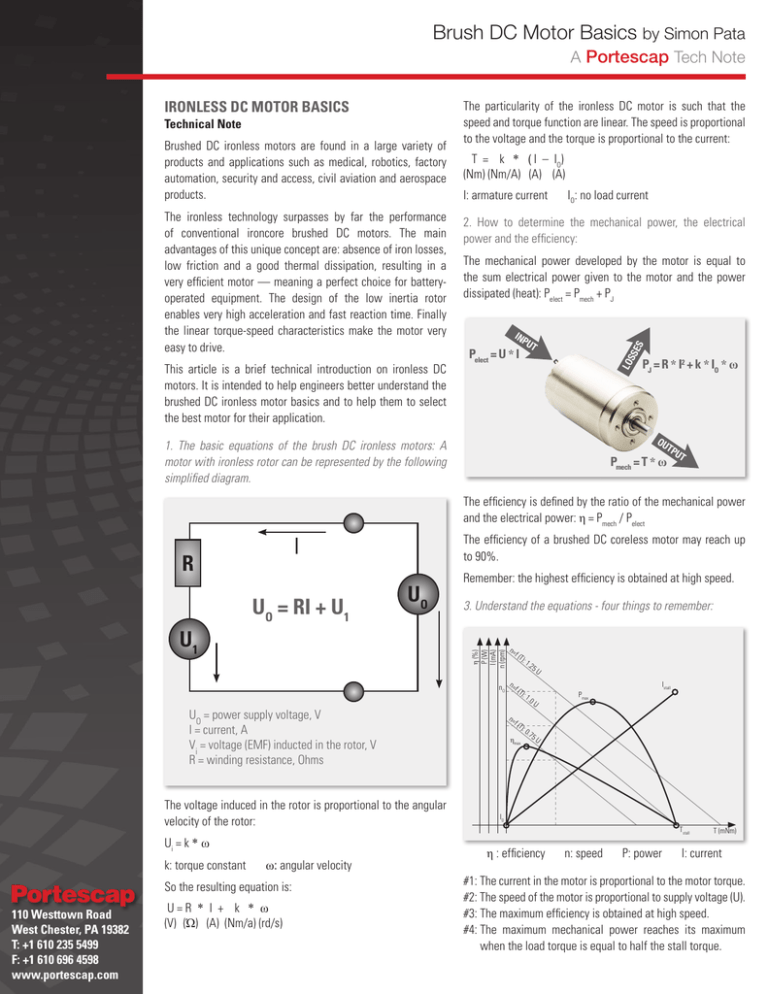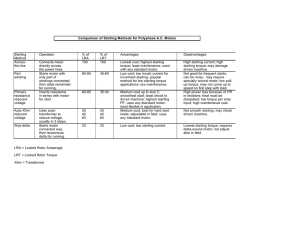
Brush DC Motor Basics by Simon Pata
A Portescap Tech Note
The ironless technology surpasses by far the performance
of conventional ironcore brushed DC motors. The main
advantages of this unique concept are: absence of iron losses,
low friction and a good thermal dissipation, resulting in a
very efficient motor — meaning a perfect choice for batteryoperated equipment. The design of the low inertia rotor
enables very high acceleration and fast reaction time. Finally
the linear torque-speed characteristics make the motor very
easy to drive.
This article is a brief technical introduction on ironless DC
motors. It is intended to help engineers better understand the
brushed DC ironless motor basics and to help them to select
the best motor for their application.
T = k * ( I – IO)
(Nm) (Nm/A) (A) (A)
I: armature current
IO: no load current
2. How to determine the mechanical power, the electrical
power and the efficiency:
The mechanical power developed by the motor is equal to
the sum electrical power given to the motor and the power
dissipated (heat): Pelect = Pmech + PJ
INP
UT
Pelect = U * I
ES
Brushed DC ironless motors are found in a large variety of
products and applications such as medical, robotics, factory
automation, security and access, civil aviation and aerospace
products.
SS
Technical Note
The particularity of the ironless DC motor is such that the
speed and torque function are linear. The speed is proportional
to the voltage and the torque is proportional to the current:
LO
IRONLESS DC MOTOR BASICS
PJ = R * I2 + k * IO * ω
OU
1. The basic equations of the brush DC ironless motors: A
motor with ironless rotor can be represented by the following
simplified diagram.
TP
Pmech = T * ω
UT
The efficiency is defined by the ratio of the mechanical power
and the electrical power: η = Pmech / Pelect
The efficiency of a brushed DC coreless motor may reach up
to 90%.
R
UO = RI + U1
UO
3. Understand the equations - four things to remember:
η (%)
P (W)
I (mA)
n (rpm)
U1
Remember: the highest efficiency is obtained at high speed.
n=
f (T
): 1
.25
n
nO =f (T
)
:1
UO = power supply voltage, V
I = current, A
Vi = voltage (EMF) inducted in the rotor, V
R = winding resistance, Ohms
The voltage induced in the rotor is proportional to the angular
velocity of the rotor:
Ui = k * ω
k: torque constant
ω: angular velocity
So the resulting equation is:
110 Westtown Road
West Chester, PA 19382
T: +1 610 235 5499
F: +1 610 696 4598
www.portescap.com
U=R * I + k * ω
(V) (Ώ) (A) (Nm/a) (rd/s)
n=
f (T
): 0
.0
ηmax
U
U
.75
Pmax
Istall
U
IO
Tstall
η : efficiency
n: speed
P: power
T (mNm)
I: current
#1: The current in the motor is proportional to the motor torque.
#2: The speed of the motor is proportional to supply voltage (U).
#3: The maximum efficiency is obtained at high speed.
#4: The maximum mechanical power reaches its maximum
when the load torque is equal to half the stall torque.
Brush DC Motor Basics
Page 2
4. How to determine the rotor temperature and the rotor resistance at this
temperature:
CONCEPT
DETAIL
(Brushed DC coreless motor maximum coil temperature is usually rated to
155° C.)
Tr =
R22 * I2 * (Rth1 + Rth2) * (1-22 α) + Ta
Ironless Rotor
1 - α * R22 * I2 * (Rth1 + Rth2)
R = R22 * (1 + α * ΔTemp)
Tr: temperature of the rotor (°C)
R22: motor resistance at 22° C (Ohms) - catalog value
I: current (A)
Rth1: thermal resistance rotor/body (°C/W) -catalog value
Rth2: thermal resistance body/ambient (°C/W) -catalog value
α: thermal coefficient of the resistance of copper (0.0039/°C)
Ta: ambient temperature (°C)
R: resistance (Ohms)
ΔTemp = Tr -22
5. How to determine the time constant of the system and the starting time
of a brushed DC ironless motor (voltage driven):
τ = τM * ( 1 + JL / JM)
Small Sized
Bearings
6. The Portescap Brushed DC Ironless technology in one glance:
Long-life patented commutator
system virtually eliminated brush
Models available from
8mm to 35mm diameter
CHARACTERISTICS
Ratafente™
Series CopperGraphic
Commutation
ADVANTAGES FOR THE APPLICATIONS
Low moment of
inertia
High acceleration, Ideal for incremental
motion
Linear speed-torque function, Insensitive to
shocks
No hysteresis
and eddy
current losses
High efficiency, low losses from friction only
Ideal for battery operation
No magnetic
saturation
High peak torques without the risk of
demagnetization
High power per
size and per
weight
Ideal for portable or small equipment or
requiring small dimenions
Low viscous
damping
Low starting
voltage
Precious Metal Low friction,
Commutation
little electrical
System
noise
t = τ * ln (ω1 / (ω1-ω) )
τ: time constant of the motor + load (ms)
τM: time constant of the motor alone (ms) – catalog value
JL: inertia of the load (kgm2)
JM: inertia of the motor (kgm2 ) – catalog value
t: starting time (ms)
ω1: angular velocity obtained after an infinite time (rd/s)
ω: angular velocity (rd/s) after a time = t
Select either sleeve
or ball bearings
Central Stator
Magnet
MOTOR
High peak speeds, very low speed dependent
losses
Low losses and wear, low electromagnetic
interference
High current
densities may
be commutated
High continuous and peak torques without
the risk of demagnetizing the motor. Very
long life. Ideal for chopper drives.
Rated motor
temperature up
to 155°C
Continuous torque is exceptionally high for
motor size, reducing the weight, dimensions,
and the cooling system.
Very compact
commutation
system
Excellent resistance to shocks and vibration
High torque to
inertia ratio
High acceleration, short mechanical time
constant
7. How to select the appropriate Brush DC motor? Let’s take a look, using a
miniature air pump application as an example.
At 6 volts, 0.6 A battery-operated miniature air pump needs to have a flow
range of 850 - 2500 cc/min which is equivalent to:
T = 3mNm of torque at 9’000 rpm (ω = 942.5 rd/s).
The requested mechanical power is:
Pmech = T * ω = 0.003 * 942.5 = 2.82 W
Ironless rotor coil enables high
acceleration
High efficiency design is ideal for
battery-fed applications
Optional gearboxes and magnetic or optical
encoders can easily be added
Portescap 16G brushed DC motor series is rated for 5W maximum output
power.
Let us consider the 16G88 -220E 1 (6v rated winding):
(See illustration and chart on Page 3.)
Brush DC Motor Basics
Page 3
5 WATT
16G88 - PRECIOUS METAL COMMUTATION SYSTEM - 9 SEGMENTS
Max screw torque: 40 mNm
Max traction: 230 N
2x 1,8 x4
10
1,5 -0,006
-0,009
6 -0
-0,018
6 -0
-0,018
M1,6 x2,8 max.
16 0
-0,1
10
6x 6
6 0,5
0º
7,050,5
1
dimensions in mm
mass: 24g
WINDING TYPE
150 0,3
1 ( 6,5 )
16G88 • 1
-220P
-220E
-213E
-211E
-210E
-208E
Measuring Voltage
V
3
6
8
12
15
24
No-load Speed
rpm
10600
10900
8000
8700
9000
10400
Stall Torque
mNm (oz-in)
16 (2.3)
19.9 (2.8)
12.7 (1.80)
12.1 (1.71)
12.2 (1.73)
14.3 (2.0)
Avg. No-load Current
mA
45
17
8
6.5
5.5
3.5
Typical Starting Voltage
V
0.02
0.05
0.12
0.18
0.20
0.30
Max. Continuous Current
A
2.0
1.21
0.55
0.42
0.35
0.25
Max. Continuous Torque
mNm (oz-in)
5.2 (0.74)
6.3 (0.89)
5.8 (0.82)
5.4 (0.76)
5.4 (0.76)
5.4 (0.76)
Max. Angular Acceleration
10 rad/s
282
277
292
273
291
272
Back-EMF Constant
V/1000 rpm
0.28
0.55
1.12
1.37
1.65
2.3
Torque Constant
mNm/A (oz-in/A)
2.67 (0.38)
5.3 (0.74)
10.7 (1.51)
13.1 (1.85)
15.8 (2.23)
22 (3.11)
Terminal Resistance
ohm
0.5
1.6
7.6
13
19.5
37
Motor Regulation R/k2
103/Nms
70
58
66
76
79
77
Rotor Inductance
mH
0.01
0.045
0.15
0.26
0.40
0.72
Rotor Inertia
kgm2 10-7
0.08
0.91
0.8
0.8
0.74
0.08
Mechanical Time Constant
ms
5.6
5.3
5.6
6.1
5.8
6.7
Measured Values
Max. Recommended Values
3
2
Intrinsic Parameters
Brush DC Motor Basics
Page 4
The first step is to calculate the current which is supplied to the motor under
the conditions described on the previous page.
T = k * ( I – IO )
I = T / k + IO = 0.003 / 0.0053 + 0.017 = 0.583 A
The second step is to determine the supply voltage to get the requested
speed.
9’000 rpm (942.5 rd/s)
U = R * I + k * ω = 1.6 * 0.583 + 0.0053 * 942.5 = 5.93 V < 6 V
Thus the motor will reach the desired speed under the specified torque
within the limitations of the battery.
Now we can determine the motor efficiency.
Pelect = U x I = 5.93 * 0.583 = 3.45 W
Efficiency* = Pmech / Pelect = 2.82 / 3.45 = 81%
Let's assume this pump
needs to reach at least
5000rpm in less than
15ms:
Load inertia: 1 x 10-7 kg.m2
Rotor inertia: 0.91 x 10-7 kg.m2
τ = τM * ( 1 + JL / JM) t = τ * ln (ω1 / (ω1-ω))
τ = 5.3 * (1+1/0.91) = 11.12ms
t = 11.12 * ln (9000 / (9000-5000)) = 9ms < 15ms
The speed of the pumps will be 5000rpm after 9ms.
This excellent dynamic characteristic is due to the ironless rotor concept.
The low moment of inertia of the rotor enables very high acceleration.
*The motor efficiency is above 80% which will
contribute to very long battery life. Achieving
such efficiency is only possible thanks to the
Portescap state-of-the-art brushed DC
ironless motor technology.
FOR MORE INFORMATION:
110 Westtown Road
West Chester, PA 19382
T: +1 610 235 5499
F: +1 610 696 4598
sales.america@portescap.com
www.portescap.com
CONTACT AN ENGINEER:
http://www.portescap.com/contact-portescap
© 2016 Portescap. All rights reserved. Lit Code: TN0001_07192016



